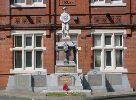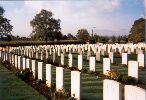
Newton-le-Willows and
Earlestown War Memorial

| OTHER WARS |
 |
Newton-le-Willows andEarlestown War Memorial |
 |
| The
Great War Roll of Honour |
|||||||||||||||||||||||||
The Official History, gives the following account:
“Finally, it was decided at a conference at l7th Division headquarters,
during which General Plumer was present, that on the evening of the lst March
a bombardment should begin at 5 P.M. and last 45 minutes, with subsequent lift
and barrage, but should then stop, every effort being used to make it appear
that an attack had been intended, but had failed to materialize. After a complete
pause, Br.-General Pratt was to decide at 2 A.M., according as the enemy had
or had not shown signs of activity in making repairs, whether or not there should
be a preliminary bombardment of twenty minutes before the assault.
The plan was not only to recover what had been lost, but to improve the British
position by consolidating a line across the Bean in front of the old re-entrant
portion. There were to be three battalions in front line: the 2/Suffolk on the
right, to assault New Year Trench, the Bluff, and Loop Trench; the 8/King's
Own in the centre; and the 1/Gordon Highlanders on the left; all with sections
of the 56th and East Riding Field Companies R.E. and small parties of tunnellers
attached to them. The 10/Royal Welch Fusiliers was to be in support of the Suffolks,
and the 7/Lincolnshire (51st Brigade) divided to support all three front line
battalions, two companies being behind the centre. The 10/Sherwood Foresters
(51st Brigade) would be in reserve. On the extreme right of the attack a raid
was to be made along the bank to destroy all the German mine shafts found there.
The British bombardment on the 1st March was most effective; the trench and
Stokes mortars available, though small in number, enabled all parts of the enemy's
works which the howitzers could not reach to be dealt with. A reconnaissance
in the afternoon established the fact that the Bluff defences were almost destroyed,
but that the trenches further north were not only far from levelled, but had
been improved and provided with fresh wire. The intense bombardment was carried
out, as arranged, from 1.5 P.M. to 5.45 P.M., an 18-pdr., pushed close up to
the front, being used to blow in 40 yards of the German front line on the left
of the part to be attacked, so as to form a "block". Then the guns
and mortars kept up a slow rate of fire during the night to prevent the enemy
from repairing his trenches or putting out fresh wire: snipers and machine gunners
fired at the same rate as usual. The night was fine and clear, and the enemy
remained quiescent, there being no gun or machine-gun fire, while his sentries
hardly fired a shot. At 2.15 A.M. on the 2nd, Br.-General Pratt reported that
he would not require the 20-minute preliminary bombardment, and that the infantry
was moving up into its assembly positions. This operation was completed by 8.45
A.M. without attracting any attention from the enemy's infantry or artillery.
At 4.15 A.M. the troops began to move forward in small groups, guided by men
of the battalions of the 52nd Brigade in the line, and punctually at 4.80 A.M.
the assault was launched. The only mishap was the explosion of a store of fireworks,
collected with great difficulty by Major-General Pilcher in order to direct
artillery fire. At 4.82 A.M. the British artillery began the barrage fire behind
the front attacked. The surprise was complete, except on the extreme left, where
a half-company of the Gordons was shot down almost to a man by a German officer
machine-gunner, eventually killed, with his crew, by an officer, 2nd. Lt. C.
Sanderson who was awarded the D.S.O. for his gallantry. Everywhere else the
front waves advanced a considerable distance, trampling down what remained of
the wire without hindrance from the enemy.
There had been a somewhat interesting preliminary to the assault. It was agreed
at the conference at which an attack without bombardment was discussed, that
the advance against the Bluff itself would be impossible unless there was covering
fire to force the Germans to keep their heads down during the movement from
the assembly trenches across No Man's Land; this would take two minutes. General
Uniacke then offered to "drill the enemy" for the purpose. A 60-pdr.
battery was detailed to fire a salvo on the Bluff trench, followed by a second
after two minutes' interval, at irregular periods by day and night. The ruse
was entirely successful; at zero hour a salvo was fired, and when the 2/Suffolk
entered the defences of the Bluff, it found the sentries under cover, expecting
no doubt the second salvo, and most of the garrison in the dug-outs excavated
in the western face of the big crater. The 8/King's Own overran its objective,
and, finding no Germans in the first two lines, reached the third across the
base of the Bean, which it used as a covering position until next evening, whilst
the objective was being consolidated. Some of the battalion went on beyond without
finding any Germans. Subsequently a party of sixty Germans behind the King's
Own front, in the old British front trench, began firing, but it was soon compelled
to surrender. The 1/Gordon Highlanders was held back for a time by the resistance
it encountered on the left; but after reinforcing twice, with the assistance
of a company of the 7/Lincolnshire, and of the 9/Duke of Wellington 's (52nd
Brigade) which had remained in the line and was protecting the left of the attack,
it obtained possession of all its objectives by 5.10 A.M.
Many of the Germans encountered had no equipment on and were without rifles.
Not a bayonet was fixed, and there was no rifle fire from the enemy's old front
trench of the 14th February after the assault. Five officers and 248 other ranks
were taken prisoner, but this total includes, 47 who remained in the Bluff dug-outs
all day and were extracted from them in the evening.
The raiding party destroyed the enemy gallery in No Man's Land leading to the
Bluff, but all the men of the 172nd Tunnelling Company employed were killed
by machine-gun fire.
It was not until 9.30 A.M. that the enemy's artillery opened, and the bombardment
did not become intense until 11 A.M. By that time the British front line had
been thinned by Lieut.-Colonel G. S. G. Crauford of the Gordons, the senior
officer in the line, and the work of consolidation was well under way; but,
as the fire continued heavy until 3.15 P.M., in spite of British retaliation,
both the old and new trenches were badly damaged and required much work before
they could be made secure. One of the old trenches became known as International
Trench, because it contained bodies of men of three nationalities who had fallen
in the 1914 battles. Some attempts at bombing attacks were made in the evening
by the enemy on the British left, but they failed completely; for once the British
bombers, equipped with plenty of Mills grenades, enjoyed the mastery.
The battalions which took part in the action were relieved on the night of the
3rd/4th by the 8th Brigade, the operation being difficult owing to the state
of the trenches, and a snowstorm which by midnight rose to a blizzard leaving
the ground thick under snow. The casualties from noon on the 1st March to noon
of the 4th had been 62 officers and 1,560 other ranks. (The German losses were
124 killed, 438 wounded and 346 missing, of whom 93 must have been killed, as
only 253 prisoners were taken.)
The operations at the Bluff were subsequently confined to mining, with the result
that on the 11th December 1916 the Bluff was reported safe from underground
attack. In consequence of information given to the Intelligence by a prisoner,
who drew a plan of the galleries, the German workings were cut off by driving
a deep system of mining through difficult ground out to and behind the German
lines and then firing heavy camouflets, under-charged mines calculated to blow
in enemy workings, but not to form craters on the surface. The German galleries
were then captured and annexed to the British shallow system. Thereafter the
Bluff was beyond molestation, until on the 7th June 1917, in the great Messines
offensive, the Germans were driven from the area.